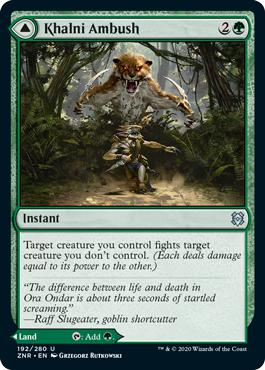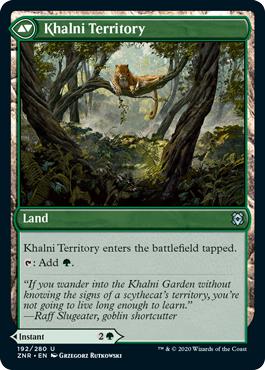- ← 191. Kazandu Stomper
-
Khalni Ambush // Khalni Territory

 //
// - 193. Lotus Cobra →
Impressions


Informations
- Extension : Zendikar Rising - 192/391 (Peu commune)

- Artiste : Grzegorz Rutkowski
Impression anglaise
- Khalni Ambush
- Instant
- Target creature you control fights target creature you don't control. (Each deals damage equal to its power to the other.)
Land : Add
: Add  .
. - "The difference between life and death in Ora Ondar is about three seconds of startled screaming."
—Raff Slugeater, goblin shortcutter - Khalni Territory
- Land
- Khalni Territory enters the battlefield tapped.
 : Add
: Add  .
.
Instant

- "If you wander into the Khalni Garden without knowing the signs of a scythecat's territory, you're not going to live long enough to learn."
—Raff Slugeater, goblin shortcutter
Impression française
- Embuscade de Khalni
- Éphémère
- Une créature ciblée que vous contrôlez se bat contre une créature ciblée que vous ne contrôlez pas. (Chacune inflige un nombre de blessures égal à sa force à l'autre.)
Terrain : Ajoutez
: Ajoutez  .
. - « La différence entre la vie et la mort dans la forêt d'Ora Ondar est un cri de surprise de trois secondes. »
—Raff Gobelimace, accourcisseur gobelin - Territoire de Khalni
- Terrain
- Le Territoire de Khalni arrive sur le champ de bataille engagé.
 : Ajoutez
: Ajoutez  .
.
Éphémère

- « Si tu te rends dans le jardin de Khalni sans savoir reconnaître les signes du territoire d'un félin à ergots faucheurs, tu ne survivras pas assez longtemps pour apprendre à les reconnaître. »
—Raff Gobelimace, accourcisseur gobelin
Oracle
- Khalni Ambush
- Instant
- Target creature you control fights target creature you don't control.
Land
{T}: Add {G}. - Khalni Territory
- Land
- Khalni Territory enters the battlefield tapped.
{T}: Add {G}.
Instant
{2}{G}
Règles
- If either target is an illegal target as Khalni Ambush resolves, no creature will deal or be dealt damage. [0000-00-00]
- There is a single triangle icon in the top left corner of the front face. There is a double triangle icon in the top left corner of the back face. [0000-00-00]
- To determine whether it is legal to play a modal double-faced card, consider only the characteristics of the face you’re playing and ignore the other face’s characteristics. [0000-00-00]
- If an effect allows you to play a specific modal double-faced card, you may cast it as a spell or play it as a land, as determined by which face you choose to play. If an effect allows you to cast (rather than “play”) a specific modal double-faced card, you can’t play it as a land. [0000-00-00]
- If an effect allows you to play a land or cast a spell from among a group of cards, you may play or cast a modal double-faced card with any face that fits the criteria of that effect. [0000-00-00]
- The converted mana cost of a modal double-faced card is based on the characteristics of the face that’s being considered. On the stack and battlefield, consider whichever face is up. In all other zones, consider only the front face. This is different than how the converted mana cost of a transforming double-faced card is determined. [0000-00-00]
- A modal double-faced card can’t be transformed or be put onto the battlefield transformed. Ignore any instruction to transform a modal double-faced card or to put one onto the battlefield transformed. [0000-00-00]
- If an effect puts a double-faced card onto the battlefield, it enters with its front face up. If that front face can’t be put onto the battlefield, it doesn’t enter the battlefield. [0000-00-00]
- If an effect instructs a player to choose a card name, the name of either face may be chosen. If that effect or a linked ability refers to a spell with the chosen name being cast and/or a land with the chosen name being played, it considers only the chosen name, not the other face’s name. [0000-00-00]
- In the Commander variant, a double-faced card’s color identity is determined by the mana costs and mana symbols in the rules text of both faces combined. If either face has a color indicator or basic land type, those are also considered. [0000-00-00]
- There is a single triangle icon in the top left corner of the front face. There is a double triangle icon in the top left corner of the back face. [0000-00-00]
- To determine whether it is legal to play a modal double-faced card, consider only the characteristics of the face you’re playing and ignore the other face’s characteristics. [0000-00-00]
- If an effect allows you to play a specific modal double-faced card, you may cast it as a spell or play it as a land, as determined by which face you choose to play. If an effect allows you to cast (rather than “play”) a specific modal double-faced card, you can’t play it as a land. [0000-00-00]
- If an effect allows you to play a land or cast a spell from among a group of cards, you may play or cast a modal double-faced card with any face that fits the criteria of that effect. [0000-00-00]
- The converted mana cost of a modal double-faced card is based on the characteristics of the face that’s being considered. On the stack and battlefield, consider whichever face is up. In all other zones, consider only the front face. This is different than how the converted mana cost of a transforming double-faced card is determined. [0000-00-00]
- A modal double-faced card can’t be transformed or be put onto the battlefield transformed. Ignore any instruction to transform a modal double-faced card or to put one onto the battlefield transformed. [0000-00-00]
- If an effect puts a double-faced card onto the battlefield, it enters with its front face up. If that front face can’t be put onto the battlefield, it doesn’t enter the battlefield. [0000-00-00]
- If an effect instructs a player to choose a card name, the name of either face may be chosen. If that effect or a linked ability refers to a spell with the chosen name being cast and/or a land with the chosen name being played, it considers only the chosen name, not the other face’s name. [0000-00-00]
- In the Commander variant, a double-faced card’s color identity is determined by the mana costs and mana symbols in the rules text of both faces combined. If either face has a color indicator or basic land type, those are also considered. [0000-00-00]
Cote
- NM/MT : non disponible
- Premium : non disponible
Classeurs
Cet espace est réservé aux membres enregistrés sur MTG Addict.
Il permet de gérer gratuitement et sans restriction vos collections de cartes. Pour ouvrir rapidement un compte MTG Addict cliquez ici. Si vous avez déjà un compte cliquez ici.